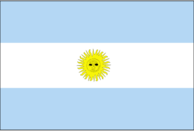Flag of Argentina
|
|
The national flag of Argentina dates from 1812. It is composed of three equal horizontal bands coloured light blue, white and light blue. In 1818, a yellow sun was added to the centre.
The full flag featuring the sun is called the 'Official Ceremony Flag' (Spanish: Bandera Oficial de Ceremonia). The flag without the sun is considered the 'Ornamental Flag' (Spanish: Bandera de Ornato). The ornamental version must always be hoisted below the Official Ceremony Flag. In vexillological terms, the Official Ceremony Flag is the civil, state and war flag and ensign, whilst the Ornamental Flag is an alternate civil flag and ensign.
Is important to note that both versions are equally considered the national flag.
| Contents |
Official description
Shape and size
As of 1978, the flag's official proportions are 9:14, and its official size is 0.9 by 1.4 metres. It features three stripes alternating cerulean blue - white - cerulean blue. Each stripe is 30 centimetres in height. In the center stripe there is an emblem known as the Sun of May (spanish: Sol de Mayo), a golden sun. Flags with proportions of 1:2 and 2:3 are also in use.
Colours
The colours are subject to discussion, and there is no official position on colour usage. The Spanish word celeste (cerulean blue) is used to describe the colour of the blue stripes. Cerulean blue's is defined by Pantone as N21-01, which equals 155, 196, 226 in RGB notation.
| Colour | RGB | HTML | HSV | Lab | CMYK | Sample |
|---|---|---|---|---|---|---|
| Cerulean Blue | 156, 196, 226 | #9BC4E2 | 201, 31, 89 | 77, -9, -20 | 37, 12, 3, 0 | |
| Cerulean Blue (Websafe) | 153, 205, 255 | #99CCFF | 210, 40, 100 | 80, -3, -31 | 35, 10, 0, 0 | |
| White | 255, 255, 255 | #FFFFFF | 0, 0, 100 | 100, 0, 0 | 0, 0, 0, 0 | |
| Golden Yellow | 255, 205, 51 | #FFCD33 | 45, 80, 100 | 85, 8, 76 | 1, 19, 89, 0 | |
| Black | 0, 0, 0 | #000000 | 0, 0, 0 | 0, 0, 0 | 75, 68, 67, 90 |
The sun
The sun, called Sun of May, is a replica of an engraving on the first Argentine coin, approved in 1813, whose value was eight escudos (one Spanish dollar).
In 1978 the sun colour was specified to be golden yellow (amarillo oro), to have an inner diameter of 10 centimeters, and an outer diameter of 25 centimeters (the diameter of the sun equals <math>5/6th<math> the height of the white stripe. The sun's face is <math>2/5th<math> of its height)
It features 32 rays, 16 undulated and 16 straight, in alternation.
In the Official Ceremony Flag, the sun must be embroidered.
History
Creation
Argentina-Bandera-P2080016.JPG
According to legend, during the Argentine wars of independence General Manuel Belgrano was commanding a battle in Rosario. He noticed that both the Crown's forces and the independence forces were using the same colors (Spain's yellow and red). After realizing this, Belgrano created a new flag using the colors that were used by the criollo during the May Revolution in 1810.
Excited by the notion of having a national flag, Belgrano dispatched a letter addressed to the First Junta, informing them of the newly created flag. The Junta, fearing the Spanish Crown, sent a warn to Belgrano not to fight under the flag but by the time the reply had arrived, Belgrano had moved on, and was flying the flag on the battlefield.
The flag was hoisted for the first time in Buenos Aires atop the Saint Nicholas of Bari Church on August 23, 1812 (where nowadays the Obelisk is located).
After the declaration of independence on July 9, 1816, the flag was adopted as a symbol by the Argentine Congress.
Changes
On February 25, 1818, a sun was added to the battle flag. The sun was copied after the one that the first Argentine coin featured in 1813. It was subsequently decided to be part of the regular flag afterwards, and thus the sun no longer represents war.
On June 8, 1938, president Roberto Ortiz sanctioned a law declaring June 20 'Flag Day', a national holiday (the date was decided after the anniversary of Belgrano's death).
In 1978 it was specified, among other measurements, that the Official Ceremony Flag should be 1.4 meters in width and 0.9 meters in height, and that the sun must be embroidered.
Myths about the flag
The most accepted interpretation of the flag is that it represents the sky, clouds and sun. However, there are several folk stories about the colors of the flag. One story says that the blue symbolizes the Río de la Plata (Silver River) and the white symbolizes silver (the name 'Argentina' comes from the Latin word for silver, argentum). Another story states that the colors are based on those of the House of Bourbon, and a third suggests that they are derived from the clothing of the Virgin Mary.
It is not known with certainty that Belgrano created the flag, but during the wars of independence against Spain, he was the first to use it, even though the criollo government didn't approve it.
Another popular belief is that the version with the sun is a war flag while the sunless version is not, but while this was originally the case after the approval of Congress in 1818, it was changed afterwards.
| National flags |
| List of national flags | List of national coats of arms |
External links
- Template:FOTW
- More information (in Spanish) (http://www.portalargentino.net/simbolos/bandera.htm)ca:Bandera de l'Argentina
de:Flagge Argentiniens el:Σημαία της Aργεντινής es:Bandera de Argentina fr:Drapeau de l'Argentine it:Bandiera argentina he:דגל ארגנטינה ja:アルゼンチンの国旗 nl:Vlag van Argentinië pt:Bandeira da Argentina sv:Argentinas flagga

